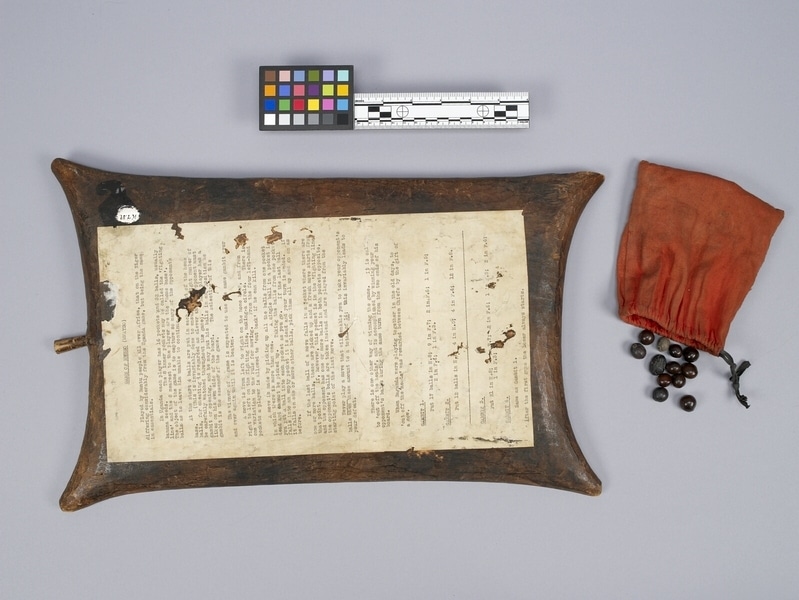Game Item Number: K4.89 from the MOA: University of British Columbia


Description
Game board (weso) consisting of a rectangular tray (eznyeso) of thirty-two squares half an inch deep (amasa). Tray rims are incised with a grid pattern. Peg at one end of the tray. There are sixty-two seeds used as counters (empiki) in an orange cloth bag which has a brown cloth drawstring. On the back of the tray, there is an explanatory paper about the game of Mweso which is played in Africa by the Bantu.
History Of Use
Weso game. Omweso is a strategy game that has been played in Uganda for centuries; the earliest board found was carved into rock and dates to the late first millennium. The game pieces represent men in combat who “fight” when in the centre two rows, and are “at home” when occupying a space on the row closest to each respective player. As a simulation of the cunning strategy necessary to win wars, omweso is embedded in the social hierarchical structures of Ganda society; boards have functioned as spiritual instruments, symbols of power, and loci for competition. The spiritual significance is demonstrated by the ceremonial game played between the prospective kabaka (king) and his katikiro (prime minister) as a coronation rite on a special omweso board known as a buteba; the game was meant to demonstrate the prospective king's ability to lead. In Ganda culture, women, barring the noblewomen, are forbidden from the game as their social rank is irrevocably forbidden from commanding men. Today, many women are fighting for an end to the gendered aspects of the game.
Iconographic Meaning
The thirty-two squares (essa, plural amasa) represent the feminine; the counters, or seeds (empiki), are considered masculine. The seeds acting as counters give the additional understanding of omweso as okusiga, meaning "to sow." The movement of the "men" is symbolic of the movements of men in battle; the power to command troops is held almost exclusively by men, which is why only men can play omweso. For a woman to play omweso, she would have symbolic control over men, which is withheld from Baganda women. Only royal princesses, whose title ssebo ascribes a level of masculinity, can play omweso.
Specific Techniques
Omweso is not yet mass-produced. As a local artisanal craft, each board is hand carved from a single piece of wood with a chisel.
Item History
- Made in Uganda
- Owned by British Museum before August 1960
- Received from British Museum (Exchanger) during August 1960
What
Who
- Culture
- Ganda
- Previous Owner
- British Museum
- Received from
- British Museum (Exchanger)
Where
- Holding Institution
- MOA: University of British Columbia
- Made in
- Uganda
When
- Ownership Date
- before August 1960
- Acquisition Date
- during August 1960
Other
- Condition
- fair
- Accession Number
- 0022/0144